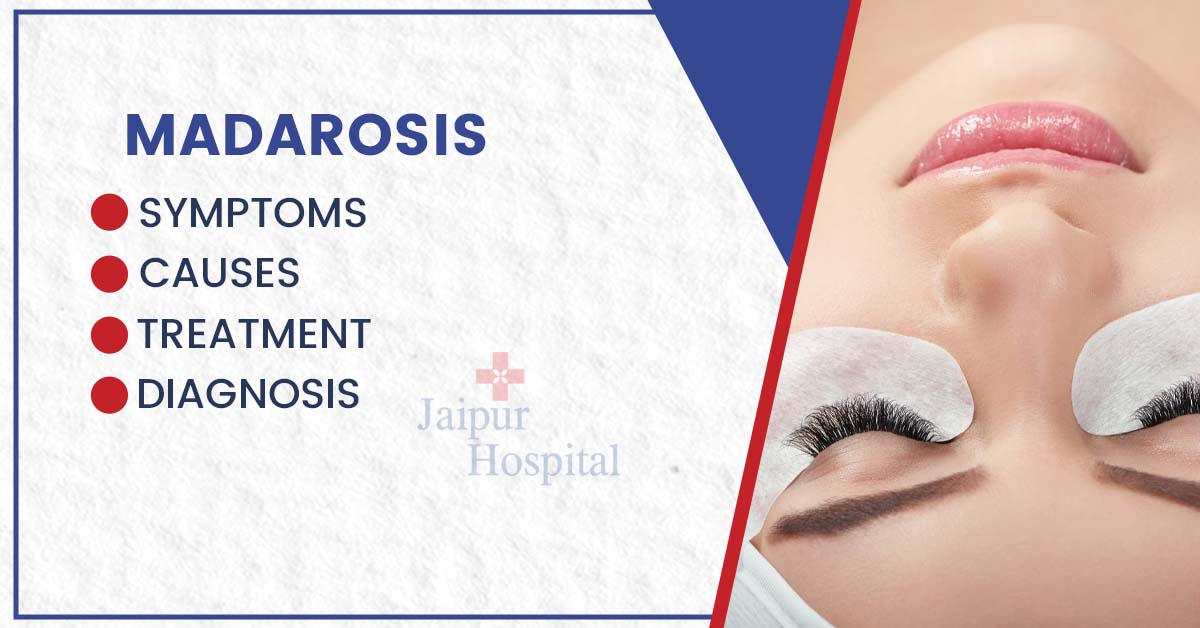What is Madarosis?
A condition called madarosis can result in the loss of eyelashes or eyebrows (superciliary or ciliary madarosis). It may only affect one side of the face or both sides. The word “fall off” is derived from the ancient Greek word “Madao,” which is how the terminology is used today.
Eyebrows and eyelashes have a purpose beyond improving one’s visual look. They stop germs, irritants, or foreign objects from getting into your eye. They have a significant impact on both facial and body expressions.
Our brows shield our eyes from sweat and precipitation. Losing hair can have an impact on a patient’s self-esteem because eyebrows and eyelashes both serve vital cosmetic purposes.
Eyelashes or eyebrows may lose all of their hair as a result of the illness. This indicates that the disorder may cause either hair thinning or total hair loss.
It’s possible for madarosis to leave no scars. Scarring indicates that your lost eyelashes or eyebrows have been permanently harmed. The temporary loss of hair from your eyelashes or eyebrows is referred to as non-scarring.
Milphosis is the sole loss of eyelashes. Madarosis may be a symptom of either localized or systemic illnesses. For more information about madarosis, keep reading.
What are the Symptoms of Madarosis?
Madarosis can be recognized by the traits listed below:
- loss of eyebrow hair
- burning and flaming eyelids
- gaining weight
- palpitation
What are the Causes of Madarosis?
Madarosis may result from numerous factors. This illness can affect both men and women, but older persons are more likely to develop it.
- Hansen’s disease (leprosy)
People with Hansen’s disease, widely known as leprosy, frequently develop madarosis. The skin, eyes, nose, and nerves are all impacted by Hansen’s disease, a bacterial illness.
- Blepharitis
Inflammation of the eyelids and eyelashes is known as blepharitis. Dry eyes, itchy, and red eyelids, as well as crust around the eyelids, are further signs of blepharitis. Eyelashes may begin to lose their lustre.
- Trauma
Eyelash and brow trauma might cause them to fall out. Accidents and injuries are examples of physical trauma. Injuries to the eye or brow region that result in burns or wounds can also cause hair loss.
- Trichotillomania
An issue with mental health is trichotillomania. People who have this disorder purposefully pluck their hair out. Eyelashes, eyebrows, and the scalp are frequently the sources of hair pulling.
- Infections
Madarosis can be brought on by bacterial, fungal, or viral diseases.
- HIV and herpes simplex virus are examples of viral infections.
- The bacterial illnesses Staphylococcus and syphilis are examples.
- Ringworm is a fungus that can cause illnesses.
You may experience other symptoms, such as redness, itching, swelling, or discomfort, if an infection is the root of your hair loss.
- Medical treatments
Your eyelashes or eyebrows may start to fall out during some medical procedures like chemotherapy, radiation, and laser treatments. These therapies target quickly proliferating cells, which can influence hair growth.
- Medications
Eyelashes or eyebrows may fall out as a side effect of certain medications, including:
- retinoids
- androgens
- botulinum toxin injections (Botox)
- anticonvulsants
- anticoagulants
- Nutritional deficiencies
Hair loss or thinning caused by nutritional deficiencies is a possibility. For instance, losing your eyelashes or eyebrows can be caused by a zinc, iron, or biotin deficiency.
- Genetic conditions
Madarosis may result from certain genetic conditions, such as:
- ichthyosiform erythroderma
- cryptophthalmos
- Ehlers–Danlos syndrome
- ectodermal dysplasia
- Skin cancer
Madarosis is a condition that occasionally indicates skin cancer. Lesions that are malignant or cancerous tend to lose their eyelashes and eyebrows more frequently than lesions that are benign or non-cancerous.
- Other diseases and conditions
Hair loss is a side effect of a few autoimmune diseases, including discoid lupus erythematosus and alopecia areata. Eyebrows and eyelashes can also fall out as a result of other conditions, such as:
- hypothyroidism
- hyperthyroidism
- psoriasis
- rosacea
- scleroderma
- atopic dermatitis
Read Also: Uterine Fibroids
How to Diagnose Madarosis:
It is important to see a doctor as soon as possible if eyelashes or eyebrows start to fall out.
- History and lifestyle
The doctor will examine about your past and way of life. This is because the development of madarosis can be influenced by a variety of circumstances, including family history, medications, allergies, poor nutrition, and injuries.
- Medical conditions
Additionally, the doctor will ask if you are suffering hair loss in other places of the body. Along with hair loss in the brow and eyelash region, other body parts may experience hair loss due to hormonal imbalance, skin conditions, drugs, and autoimmune diseases. The doctor will arrange some diagnostic testing for underlying medical issues if hair loss is evident in other body regions.
- Physical
It will be determined by looking at the eyelashes, eyebrows, and other regions of hair loss:
- Amount of hair loss
- locations and hair loss patterns
- Rate of hair thinning and growth
- localised lesions or blepharitis present
- the existence of skin inflammation and irritation
- trichotillomania is present
Read Also: Personal Hygiene Tips for Hair
Treatment for Madarosis:
- Surgery
In serious cases, eyebrow hair follicular transplantation is an option. Small incisions are made, and hair is transplanted onto the area that is balding. The treatment does not include stitches or cuts, and the hair will grow in a few months following the operation.
- Topical medications
The two most widely used medications that can lengthen or thicken eyelash hair are latanoprost and bimatoprost. Treatment for eyebrow hair the loss is also made easier with topical medications.
- Biotin supplements
These support the growth of new hair and assist in repairing damaged hair texture. Vitamin H assists in enhancing the keratin structure, which is the basis of hair, and aids in hair regrowth.
- Borax
This may aid in the treatment of poisons and infections, encouraging the growth of new hair. Applying borax to brows and eyelashes requires diluting it. According to some reports, it can even fill in bald spots and encourage hair growth.
- Psychiatric help
People who have trichotillomania are an example of this. The individual will benefit from psychiatric assistance by receiving psychological and behavioral support.
- Cosmetic treatments
To cover the thinning of your eyebrows and eyelashes, you can take a number of steps, including wearing artificial eyelashes, having your eyebrows or eyelashes tattooed, etc.
Home remedies to prevent Madarosis:
The condition can also be treated by making some changes to your daily routine, in addition to the available treatment options.
- Castor oil: Applying the oil helps protect you from losing eyelashes. In the event of any inflammation, it aids in soothing the area and promotes the growth of eyelashes. Infections can be cured with the aid of castor oil.
- Protein and fatty acids: Eating a diet high in protein will help you re-grow your eyelashes and eyebrows. Protein helps to strengthen and encourage hair growth.
- Make-up care: When applying makeup, exercise extra caution. When applying makeup, avoid using stale or crusty products, and remove all of it before bed, paying specific attention to your eyes.
- Aloe vera: This natural remedy is among the best for thinning eyebrow hair. Simply crush a few aloe vera leaves, gently massage the juice onto your brows, and allow it to absorb. It promotes hair growth and skin healing.
- Onions: Brow hair grows back more quickly and densely when onions are used. To get the most out of an onion, simply grind one and rub the juice on your brows with a cotton ball without washing them first.
- Milk: Because milk and milk products are high in proteins and vitamins, they nourish the scalp and promote quicker root regrowth. Simply dab a cotton ball in milk and rub it over your brow at night to reap the rewards.


